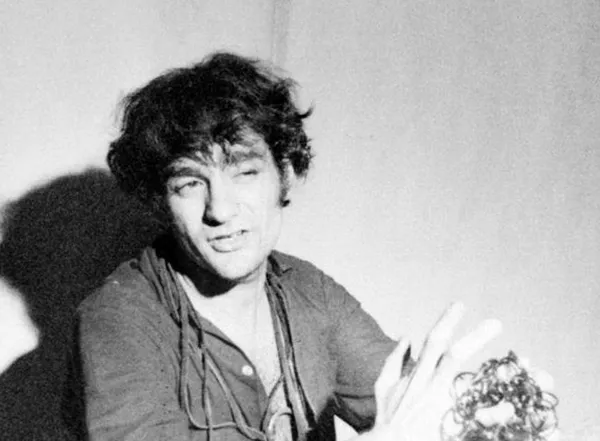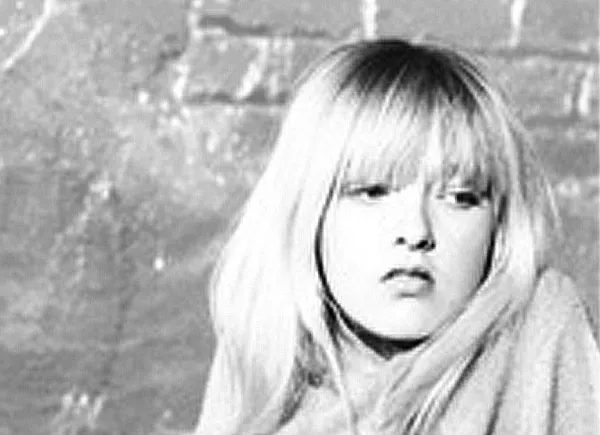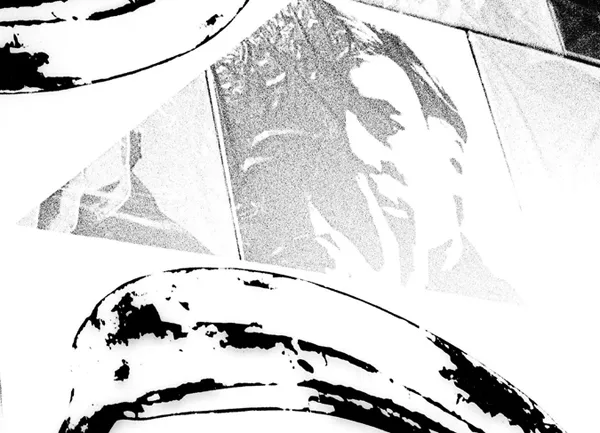![]()
… SILVER FAMILY
I find that people are fantastic, fantastic, fantastic.
—Andy Warhol
Ivy Nicholson: At the Jonas Mekas Film Culture Award* ceremony, Andy wanted me to eat a banana which I refused. So I got an apple. I was a Countess, after all, married to Regis Du Poleon, but I didn’t care if people were titled or wealthy. I had already met kings in my life, multimillionaires. I was one of the most famous models in the world, so I wasn’t that impressed—I only had eyes for Andy. And the decor! At the Silver Factory, most of the people were poor, but the decor was incredible! Everyone had their own little magic space. It was like a painting.
Ivy in a magic space …
Ondine in a spacy place …
Bibbe in a ‘Prison,’ at the tender age of sixteen, behind silvered Factory walls.
Andy in a self-portray, in a favorite pose, with a favorite fruit. (All Photos: Billy Name)
* * *
The Silver Factory, fruits aside, also became a refuge for barely ripe nubiles. Jonas Mekas, who helped out a lot of lost kids with apprentice jobs, filmed one of the most delightful of Warhol discoveries, the future mother of Beck. (If you have to ask, you’re reading the wrong book). There she is, gaily picking flowers while meandering through a pastoral Central Park. For this teenager, reality was quite a bit starker …
* * *
Bibbe Hansen: I was on the streets and not living at home. Not being anywhere. Even though it was the sixties we had just come out of the fifties. Young kids were not supposed to be running around the streets and not going to school or things like that. I remember going to dinner with Andy and Gerard and the rest, and one thing led to another. I wound up going back to being a permanent guest, not only the city, but of the state for a couple of years. So, I was out of circulation for a while.
* * *
The angelic-looking Bibbe Hansen let out a delicate peal of laughter. With her long flaxen blonde hair and innocent eyes, it was hard to believe she’d been so often a truant. Despite—well, perhaps because of—her famous artist father (Al Hansen), she was forgotten and went hungry a lot, and got into trouble with the police. After forays on the easily mean streets of Greenwich Village and lower Manhattan, she periodically wound up in Juvenile Detention centers, and Family Court, then on 23rd Street, across from the Chelsea Hotel. Bibbe, serene, arty and streetwise, grew up and gave birth and raised that inventive and brilliant musician who continues to astonish us. As for the adolescent Bibbe’s Factory Family, I doubt she had much in common with a big-haired super-socialite like Jane Holzer or a silver-spooned heiress like Ultra Violet, though back then it seemed everyone left home, even Ultra.
* * *
Ultra Violet: There were a lot of runaway kids. In a way I was a runaway; I ran away from France, from my family, was sent to a correction home. I was even exorcised! I was a rebel, so you still have to find a place where you can fit somehow. It’s like a dog without a master; you’re lost. The Factory was a place where we could hang out. Edie was certainly a runaway from her family; she rebelled. A lot of loose kids. We were a nucleus there. We can’t call it home, let’s call it a nucleus, and it’s good to be in a nucleus. You have to be part of something. So that Factory was there to swallow up people, to give them something to do.
Jonas Mekas: Andy’s Superstars. The first ones came from the underground, from the friends of filmmakers that he met, those who had been in the films of Jack Smith or Ron Rice. But then the second set were the lonely desperate souls that came from different parts of the country, and they somehow ended up at the Factory. Andy never said no, never rejected. So, sad and desperate as they were, they felt at home. Andy was like their big father. He never scolded them, never disapproved. They were permitted to improvise, to say whatever they wanted.
* * *
Filmmaker Jonas Mekas knew most of the Warhol stars who flamed out early, and seems to have worried about them considerably more than Warhol, especially in their drug-fueled frenzies … While on location in New York in our own filmmaking frenzy, we also encountered, mostly at downtown parties, the steadfast companions who worshipped those fragile fledgling Superstars, who constantly fretted about them, and who never got over them—like Danny Fields, former music manager of The Ramones, who appeared in a number of Warhol films with his adored one-time roommate Edie Sedgwick. He remembered, rather wistfully, how they first met …
* * *
Danny Fields: We were Harvard drop-outs living in New York, and one weekend in 1964, they said, “There is this pain-in-the-ass debutante, we can’t do anything with her, she has to get out of school, she has shoplifted too much, and blah blah.” But Edie was the belle of the ball of the Cambridge that I had left behind, a crowd of fabulous last names and affiliations. They were divine, and Edie was one of them. Now she needed a place to stay, so somehow it was arranged she was going to stay at my loft, my mini-loft in New York … Let’s just say it was a disaster. She was very demanding, very much a diva, on the phone day and night, chain-smoking cigarettes, checking her clothes and pulling them off. She was making me crazy, although she was adorable, and she was beautiful and she was wonderful and she was funny. And she was a great thief! I had to inspect her every time she walked out the door. Sure enough, there would be a big bottle of Listerine mouthwash. “Why are you taking this? You can afford mouthwash.” So, her mother came to find her a suitable apartment on 63rd Street, which they decorated with a huge false rhinoceros and incredible crystal and of course it burned down. That was the first apartment to burn down—this was early ’64. We all went to the World’s Fair and when we came back, Edie hops off to the Factory where she met Andy, and he fell in love like everyone else did. She signed every check in town. She was the perfect sidekick for him, so Gerard was replaced by her. He couldn’t be too smart. He was not always on Andy’s side, but Edie was, and Andy was her introduction to New York.
Gerard Malanga: Andy and I were at a party at a film producer’s house, Lester Persky, and that is where we met Edie Sedgwick. I really wouldn’t factorize Andy being a father to Edie. I would say more of a confidant, more on the level of friend, supporter, companion. They went to a lot of parties together. We did things together.
* * *
Gerard may have been the Factory stud, but he apparently never got to first base with androgynous ‘poor little rich girl’ Edie, since she was in thrall to Harvard grad confidant Chuck Wein. The muscular blue-eyed blond newcomer no doubt woke up the green-eyed monster in Malanga. Wein seemed a bit shady to those who had dealings with him, referring to him as ‘Edie’s puppet-master.’ It was the early sixties, and there was loads of semi-mystical crap flying about, though I expect Warhol was immune to it … With the arrival and rapid ascent of the waif-like Edie, Jane Holzer realized her days on Warhol’s ‘Girl of the Year’ throne were numbered, and abdicated with a sense of relief. The crazy meth-heads, drug addicts, and giggling amyl-nitrite poppers would simply carry on with their new fag hag, who clearly adored them.
* * *
Louis Waldon: Andy was working in the beginning with people who were insane. They could tell great stories, all these crazy people. But in Ondine and Taylor, Andy had great actors. They had created this movement. No editing, no script, nothing but what you have right there. If you wanted music, Taylor would put a radio on. And Andy went along. He seemed to get everyone to do what he wanted, but people already had their minds made up. Andy just let them do it. And he never said “Fifteen Minutes of Fame.” Someone said that one day, and I heard them say it. Andy just adopted everything; ...




